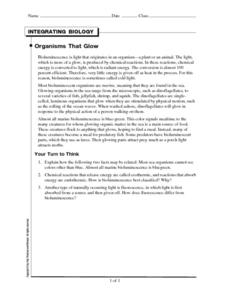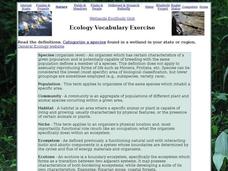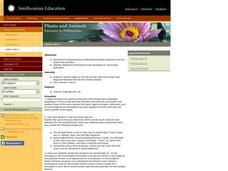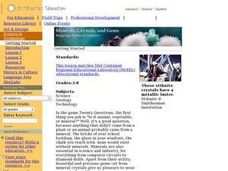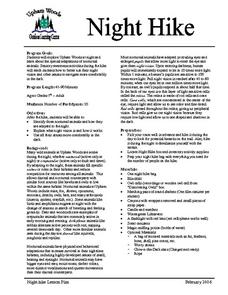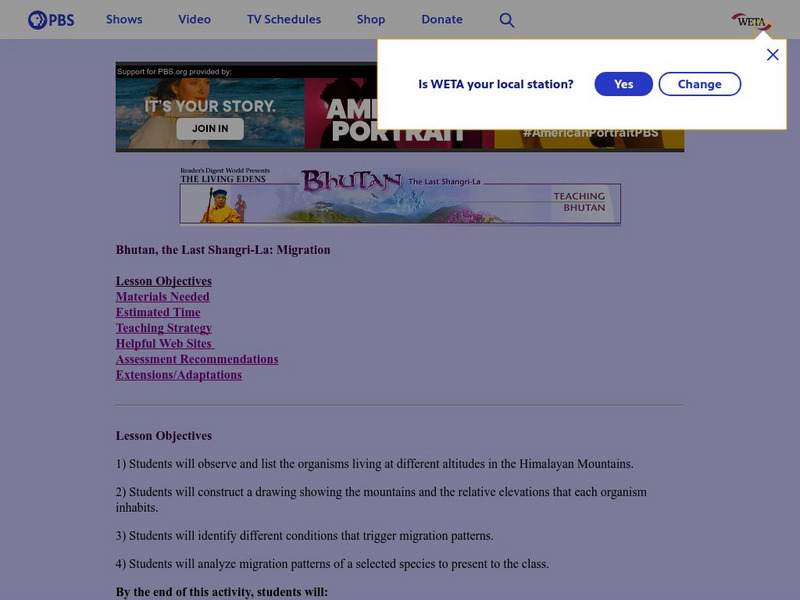Curated OER
Baga Drum
Students examine a Baga Drum in order to explore the history of the Baga people of West Africa. In this art history lesson, students recognize figures used in Baga Drum design that represent aspects of Baga culture. They also design and...
Curated OER
Organisms that Glow
In this bioluminescence worksheet, students read about various organisms that glow on land and in the sea. They answer three critical thinking questions after reading about these chemical reactions.
Curated OER
Problem Solving
Learners use hockey sticks to pick up bean bags and put them into hoops which they get money for in the end. In this movement and math lesson plan, students get fake money and add up how much they earned in the end based on how many...
Curated OER
What time is it, Mr. Clock?
Students practice telling time through movement, teamwork and cooperation - as they demonstrate how a clock represents time. They play a game of telling time in order to master the lesson objectives.
Curated OER
Ecology Vocabulary Exercise: Wetlands
In this ecology vocabulary exercise: wetlands worksheet, students read the definitions of 8 words, then categorize a species found in a wetland in their region. This page has numerous links to helpful web resources.
Curated OER
Plants and Animals: Partners in Pollination
Students describe the complementary relationships between pollinators and the plants they pollinate, identify adaptations that flowers have developed to "encourage" pollination, and create and draw their own "designer" flowers.
Curated OER
Going...going...gone? Tropical Rainforests-How They Work, What They Do for Us, What's Being Done to Them...
Sixth graders explore the Tropical Rainforest and come to understand what it is and how it affects the ecosystem. In this rainforests lesson, 6th graders write about the Tropical Rainforest, imagine they are in the Tropical Rainforest,...
Curated OER
Minerals, Crystals, and Gems
Students discover the relationships between minerals, crystals and gems. They bring in rocks that they find at home, in the schoolyard, etc. and examine them and attempt to identify them. They set up a classroom exhibit that includes all...
Curated OER
Plants and Animals: Partners in Pollination
Students identify the plant parts and bee structures that are involved in pollination. They simulate pollination in a group activity and process the information.
Curated OER
Night Hike
Students explore Upham Woods at night and investigate about the special adaptations of nocturnal animals. They identify three nocturnal animals and how they are adapted to the night. Students explain what night vision is and how it works.
Curated OER
Seabird Survival Adaptation Card Game
Students study seabirds and how they have adapted to their environments. In this activity based lesson students will play a card game that will allow them to have a better understanding of seabirds and their adaptations.
Curated OER
Making Sense of Unusual Findings
Students work on the development of observation skills and seeing how they can be used in different contexts. The lesson is good for helping the beginner and novice, along with encouraging and reminding the expert observer of right...
Utah Education Network
Uen: Animal Adaptations
A multitude of activities provide help with understanding animal adaptations.
Scholastic
Scholastic: Study Jams! Science: Animals: Animal Adaptations
A video and a short multiple-choice quiz on the topic of animal adaptations, that look at physical and behavioral adaptations.
PBS
Pbs Learning Media: Brain Break I See Animals Lesson Plan
In this interactive lesson, students act out animal movements for a short brain break.
PBS
Lesson Plan: Organism Migration in Bhutan
Science lesson plan that teaches students about plant & animal migratory patterns in the various zones of Bhutan. Part of the PBS website devoted to Bhutan.
A-Z Animals
A Z Animals: Animal Facts: Robin (Erithacus Rubecula)
Provides photographs and a fact card about the robin, as distinct from the American robin, which is actually a thrush. Explains where robins are found, their physical characteristics, diet, migration behavior, mating, and predators.
Utah Education Network
Uen: Can You Do It? I Can Do It!
In this lesson students focus on physical movement while they make the same movements different animals would make.
Smithsonian Institution
National Museum of Natural History: Where Do Mammals Live?: Wildebeest
Brief illustrated overview of the wildebeest and an accompanying video demonstrate the physical adaptations that allow this animal to eat and digest tough African grasses.
Other
Arizona Sonora Desert Museum : Animal Fact Sheet: Townsend's Big Eared Bat
This fact sheet on Townsend's Big-Eared Bat provides details on physical characteristics, migration, range, habitat, conservation, diet, reproduction, and other extra-fun facts.
Other
Arizona Sonora Desert Museum : Animal Fact Sheet: Big Brown Bat
This fact sheet on the big brown bat provides details on physical characteristics, migration, range, habitat, conservation, diet, reproduction, and other extra-fun facts.
Other
Arizona Sonora Desert Museum : Animal Fact Sheet: Mexican Free Tailed Bat
This fact sheet on the Mexican free-tailed bat provides details on physical characteristics, migration, range, habitat, conservation, diet, reproduction, and other interesting facts.
Other
Arizona Sonora Desert Museum : Animal Fact Sheet: Pallid Bat
This fact sheet on pallid bats provides details on physical characteristics, range, migration, habitat, conservation, diet, reproduction, and other extra-fun facts.
Other
Arizona Sonora Desert Museum : Animal Fact Sheet: Spotted Bat
This fact sheet on spotted bats provides details on physical characteristics, migration, range, habitat, conservation, diet, reproduction, and other extra-fun facts.



